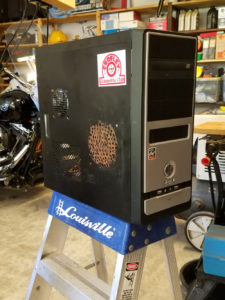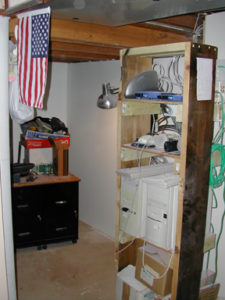This is a story about Hydra. Hydra’s a box, a computer, that up and died the death that old machines sometimes do.

I’m not 100% certain why Hydra’s dead, but pulling everything except the CPU still won’t elicit so much as a measly POST beep from the aged motherboard. I meter-tested the power supply. (I had another box on the bench for a PSU replacement, so I briefly stuffed the new PSU into Hydra just to make sure.) There’s nothing left to die except the mobo or CPU!
“So what,” I hear you thinkin’, “who TF cares about yer old box?”
Well, I do.
See, Hydra’s served the house in various capacities for a long, long time before retiring to the un-insulated sun room by the pool deck – most definitely an unfriendly environment for computers. The moisture, for one: Florida’s humid. The there are the temperature swings; in winter it can drop to near freezing and closed up in the summer it might reach 115F – or more. Environmental extremes have been the story of Hydra’s life. Finally, Hydra’s kinda remarkable in that it’s one of the oldest processors that Windows 10 will run on: the AMD Athlon 64 3200+.
So yeah, it’s worth taking a few minutes to write about little Hydra’s uncomfortable life.

For that we have to go back to Monday, October 16, 2006. That’s the day I walked into a local Comp-USA (remember that name?) with the idea of upgrading the house servers. At that time there were two. A more-than-10-year-old Pentium Pro box named Dex running Win2K Server, and a slightly newer Pentium II box named Reptar doing file server duty. Dex and Reptar were simply running out of gas.
I wanted a 64-bit CPU, a couple of GB of RAM with room for some future expansion. Remember, memory was considerably more expensive than it is today. I wanted the ability to use my existing IDE drives plus some SATA ports for later. I wanted a PCI bus. Overall, just something a bit more modern, something that would run VMware so I could segment the family’s workload.
I walked out with basically this:
- BFG NForce 4 Ultra 939 motherboard – $140
- AMD A64 3200+ Venice CPU – $120
- 2 x PC3200/2700 1 GB DDR RAM – pricey at $240
Plus assorted support stuff like a cheap case, power supply, optical drive, and so on. Came to about six hundred bucks. Sure, I could have done better online but WTF, that’s what retail’s all about; getting it now. I assembled and IPLed the box that very afternoon and Hydra took up residence in the dusty, dark basement. Right next to the furnace. So Hydra’s twenty-four seven life began.
Hydra survived much abuse. The second phase of the basement refinishing project comes to mind. The drywall work deposited a coating of dust on Hydra’s innards that called for a weekly blowout to keep it from burning up. The un-insulated NJ basement was a harsh home.
Over the years came more memory, a couple of hardware RAID cards, more drives, and still more drives. That little case became dense and heavy. And ugly, as I cut more holes for fans. Yeah, it got loud, too, but in the basement it didn’t matter.
Win2K Server gave way to a bare-metal hypervisor for a while. Fast like shit through a goose, but tricky to administer. Bare-metal gave way to Linux. Hardware RAID gave way to software. The years passed.
In December 2012 we moved to Florida. We unceremoniously tossed Hydra into a U-Haul trailer with the rest of the stuff we didn’t trust the movers to handle and pulled to its new home.
Environmentally the new network closet was an absolute step up. But Hydra screamed like a jet on full afterburner with all those drives and fans. In the old basement it didn’t matter but the closet’s just off the office, quite distracting…
By the end of the first quarter of 2013 Hydra entered a much-needed semi-retirement. The replacement, named dbox, was a quad-core box from the parts shelf, with way more memory and fewer, but higher capacity drives. By then all the server roles were running as virtual machine guests. The migration was super-fast and super-easy.
In the garage, Hydra rested on the parts shelf before being called upon to support a Facebook project Pam had launched. I don’t really remember exactly when that began. Hydra was much quieter, stripped to a single drive running Windows 7. We shoved the headless case under the healing bench near the door and Pam ran her project from her Windows desktop, logged in using the Remote Desktop Connection tool. It wasn’t the highest performance configuration in the world but it got the job done.
Without the benefit of a proper UPS poor Hydra suffered a new peril: power glitches. We got used to looking for the power light under the workbench as we passed. If it was dark anyone could thumb the power button and go about their business.
That arrangement lasted about a year. Pam’s project wound down and Hydra went back into retirement.
Meanwhile, in the real world Windows 10 was getting legs. I’d come to like the Tune In Radio app. One can only take so much country and classic rock from the local stations and I’d had my fill. I wondered… could a Windows 10 box and Tune In Radio bring superior tunes to the pool deck? Was there any spare hardware around that could run Win10? Microsoft took great pains to exclude older hardware, even while offering free upgrades. Would Win10 run on Hydra’s CPU, now approaching twelve years since its introduction?
It turns out the answer was yes! Well, there were issues to overcome along the way, but yes.
A Win10 license costs more than the budget for this venture, which was exactly zero. Microsoft was still offering free upgrades from Win7 so the plan was to follow that path. Hydra had a Win7 Pro 64-bit OS from Pam’s project so we got that upgrade started. The several-gigabyte download took forever over the crappy ADSL connection. Then the upgrade failed.
That’s how I learned that Hydra’s Athlon 64 CPU doesn’t support the CMPXCHG16B instruction. This instruction, commonly called CompareExchange128, performs an atomic
compare-and-exchange between 16-byte values. And 64-bit Win10 (and 64-bit Windows 8.1) requires this instruction.
CMPXCHG16B isn’t required by a 32-bit Win10. The path became clear. Install a 32-bit Windows 7. This meant giving up any installed memory over the 3.5 GB mark. Fine. Get Windows 7 activated. Install all the service packs and patches. Finally, upgrade it to Win10. Remember that crappy little error-prone ADSL connection? That, along with the lengthy downloads and general slowness of the ancient hardware… there went a couple of days. Thankfully it didn’t need much attention.
But it worked!
And that’s where Hydra lived out its days. Providing great radio out on the pool deck. Enduring temperatures from near-freezing to well over a hundred degrees.
The evening of May 15, 2017, I attempted to kick Hydra to life to collect the latest Win10 updates. I thumbed the power button, and heard it starting up as I walked away. Later I noticed it had gone down. Hydra never booted again.
A few interesting observations…
- Hydra began and ended life on a Monday. (Watch out for Mondays.)
- Hydra ran ten years and seven months. 10-7. If you remember the old 10-codes the cops and CBers used to use, 10-7 means “out of service”.
- Hydra ran 24/7 for most of its life. If we assume about 9 years of total running life, that works out to about three-quarters of a cent per hour against its original installed cost. Absolutely worth every nickel.
- Hydra died on its side, on the floor, in an overheated room, alone, behind the bar. A noble death.
And that’s where today’s story ends.
Maybe you’ve got an old AMD Athlon 64 3200+ floating around in your parts bin? Maybe you’d like to give it a new home? If it resurrects Hydra then it’s mine and I’ll give you a nice, fat mention in this story AND a link in the sidebar. If not, I’ll send the chip back to you with my thanks for a noble effort.
But wait! What about the tunes out on the deck? It just might be resolved. Well, at least some preliminary testing seems to show that it can be resolved with a little bit of creativity.
So that part of the story needs to wait. But I can promise you that if this scheme works it’ll be even weirder.
